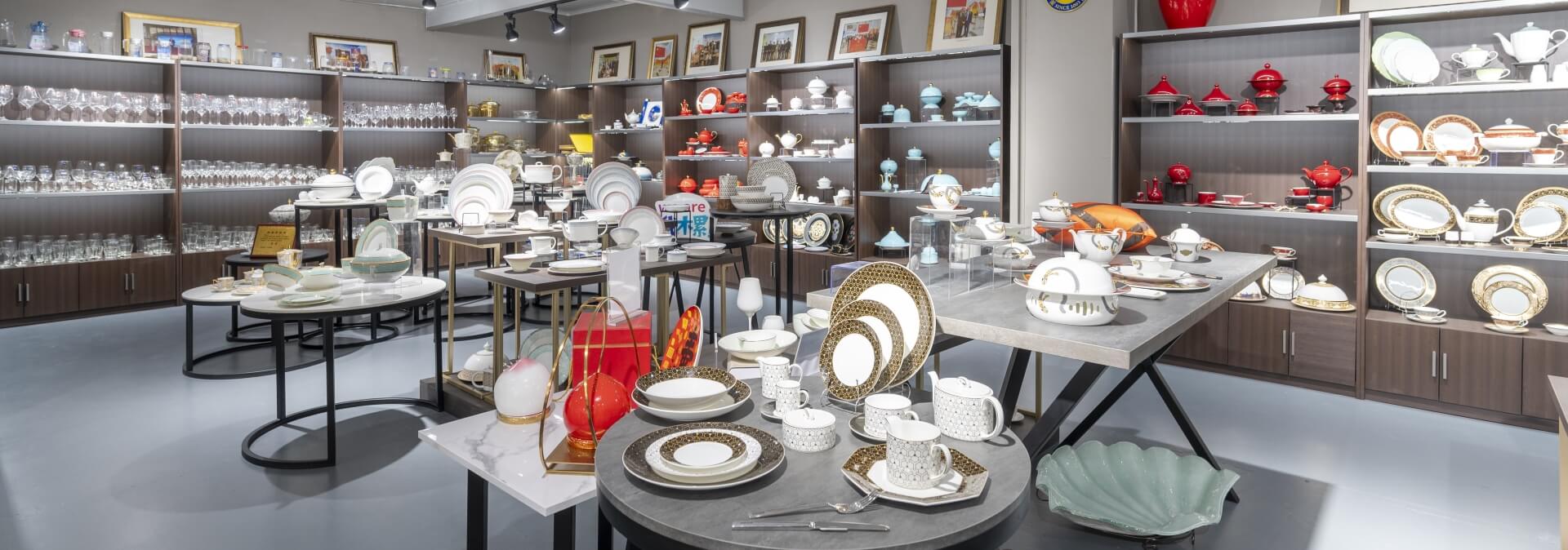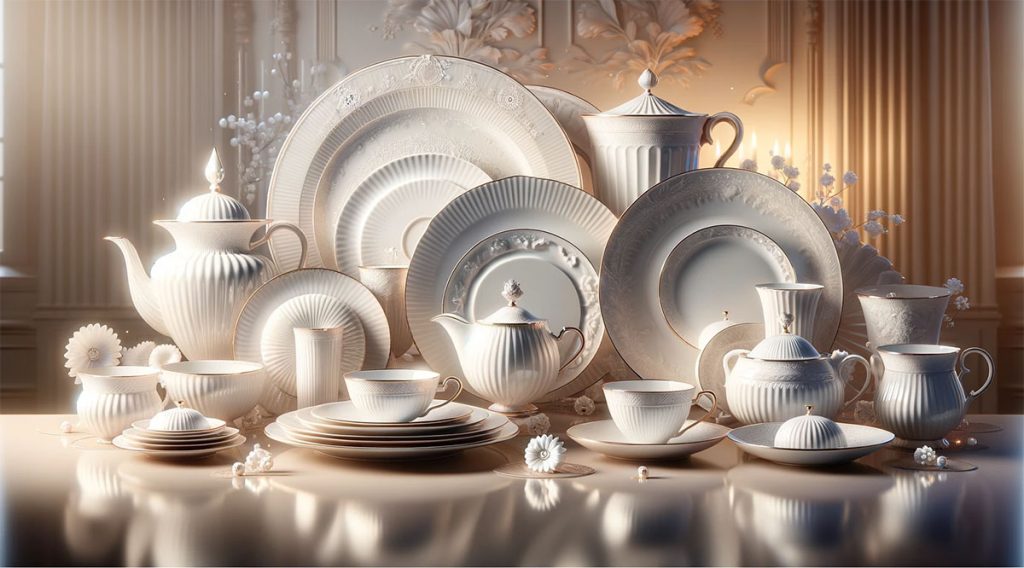
Article
Bone China: Elegance and Tradition in Fine Porcelain
Bone china, renowned for its exquisite beauty and exceptional quality, represents the pinnacle of fine porcelain. Esteemed for centuries, it embodies a fusion of artistry and refinement, making it a prized possession in households and collections worldwide. This delicate material, known for its milky white translucence and remarkable strength, has a rich history that traces back to 18th-century England. In this article, we will delve into the intriguing world of bone china, exploring its storied past, unique composition, and the meticulous craftsmanship that goes into each piece. We will also uncover its distinguishing features, various applications, and the cultural significance that has cemented its status as a symbol of elegance and tradition in the realm of fine porcelain.

The History of Bone China
Bone china, a hallmark of refined elegance in porcelain, has its roots deeply embedded in 18th-century England. Its inception is credited to Thomas Frye, who, in 1748, first attempted to mimic Chinese porcelain’s much-admired qualities. However, it was Josiah Spode, an English potter, who, in the late 1700s, perfected the formula that gave bone china its distinctive characteristics: a blend of bone ash, china clay, and china stone. Spode’s innovation not only enhanced the material’s durability but also endowed it with a captivating translucency and a pristine, ivory-white finish.
The allure of bone china swiftly captured the imagination of the aristocracy and the wealthy in Europe, symbolizing both luxury and social status. As its popularity grew, the manufacturing technique spread beyond England, reaching other European countries and eventually, various parts of the globe. The unique charm and superior quality of bone china established it as a coveted material for fine dinnerware and ornate objects, a status it maintains to this day. This spread marked the beginning of an enduring legacy, positioning bone china as a treasured art form and a testament to the ingenuity of its English creators.
What is Bone China
Bone china is a type of porcelain that is recognized for its exceptional quality and notable whiteness, translucency, and strength. Distinct from other types of porcelain, it is primarily made from a mixture of bone ash, kaolin (a pure clay), and feldspathic material. The inclusion of bone ash, typically comprising about 30% to 50% of the composition, is what fundamentally sets bone china apart from other porcelains. This unique blend not only lends bone china its characteristic milky white appearance but also contributes to its notable strength and chip resistance, despite its thin and delicate construction.
One of the most distinguishing features of bone china is its remarkable translucency. When held up to the light, bone china exhibits a certain level of transparency not found in other types of porcelain, a quality that is especially valued in fine dinnerware and decorative pieces. Additionally, bone china has a softer, warmer white hue compared to the bright white of most porcelains, giving it a subtle yet distinct aesthetic appeal.
In terms of manufacturing, bone china requires a high level of skill and craftsmanship. It undergoes two firing processes: the first at a high temperature to bisque-fire the ware, and the second, a lower-temperature glost firing to solidify the glaze. This process results in a strong yet refined material, capable of being fashioned into extremely delicate and intricate shapes.
When compared to other types of porcelain, bone china stands out for its superior strength, which is a direct result of the bone ash content. Standard porcelain, while also durable and fine, lacks the same level of chip resistance and the distinctive translucency that bone china offers. Earthenware and stoneware, other common types of ceramics, are much more opaque and heavier, and they lack the refined, delicate nature of bone china. This combination of durability, translucency, and a rich heritage makes bone china a coveted material in the realm of fine tableware and collectibles.
Bone China Composition and Manufacturing
The composition of bone china is a delicate balance of specific materials, each contributing to its unique properties. Central to its formula is bone ash, derived from animal bones, which typically constitutes about 30% to 50% of the mixture. Bone ash is responsible for the distinct translucency and strength of bone china. Kaolin, a pure white clay, is another key ingredient, offering plasticity during shaping and a white color after firing. The third component is feldspathic material, a type of mineral that acts as a flux, helping the mixture to fuse and form at a lower temperature than standard porcelain.
The manufacturing process of bone china is intricate and demands meticulous attention to detail. Initially, the raw materials – bone ash, kaolin, and feldspathic material – are finely ground and mixed in precise proportions. This mixture is then formed into the desired shapes, a process that can be done by hand or using molds, depending on the complexity and design of the piece.
Once shaped, the items undergo a first firing, known as bisque firing, at a temperature of around 1200 to 1300 degrees Celsius. This step hardens the material and prepares it for glazing. After bisque firing, the pieces are coated with a liquid glaze, which upon the second firing, known as glost firing, vitrifies to form a smooth, glass-like surface. Glost firing is done at a slightly lower temperature than bisque firing, typically around 1100 degrees Celsius. This two-stage firing process is crucial in achieving bone china’s characteristic strength and translucency.
Finally, any decorative elements, such as patterns or gold trim, are applied, often requiring additional firing at lower temperatures to set the decorations. The result is a fine, luminous, and strong material that is highly prized in tableware and decorative items.
Distinguishing Features of Bone China
Bone china is celebrated for its distinguishing features, which set it apart from other types of porcelain and ceramics. Firstly, its translucency is a hallmark of its quality. When held up to light, bone china exudes a distinctive, almost ethereal glow, allowing light to pass through, which is not characteristic of standard porcelain or earthenware. This translucency is a direct result of the high proportion of bone ash in its composition.
The whiteness of bone china is another defining trait. Unlike the stark, bright white of regular porcelain, bone china has a softer, more natural shade of white, often described as creamy or ivory. This unique coloration adds to its appeal in fine dinnerware and decorative objects.
Durability is also a key feature of bone china. Despite its delicate appearance and lightweight nature, it is surprisingly strong and resistant to chipping, owing to the strength imparted by the bone ash.
To identify genuine bone china, one can perform a few simple tests. The weight test involves comparing the heft of the piece to other ceramics; bone china is usually lighter. The sound test involves gently tapping the item; bone china produces a distinct, resonant ring, unlike other ceramics. Lastly, the light test, as mentioned, involves holding the china up to light to check for its characteristic translucency. These tests help in distinguishing genuine bone china from other similar materials.
Bone China Uses and Applications
Bone china, revered for its elegance and durability, is predominantly used in high-end dinnerware and ornamental objects. Its luxurious appearance and resilience make it a favored choice for formal dining occasions, elevating the table setting with a touch of sophistication. In addition to tableware like plates, cups, and saucers, bone china is also crafted into delicate figurines, vases, and other decorative items, often gracing the shelves of collectors and connoisseurs.
In various cultural and social settings, bone china holds a place of esteem. It’s a popular choice for wedding gifts, heirlooms, and special occasion gifts, symbolizing not just luxury but also a respect for tradition and quality. Its use in these settings reflects an appreciation for fine craftsmanship and enduring beauty, making bone china a timeless treasure in both functional and decorative realms.
Caring for Bone China
Caring for bone china requires gentle handling to maintain its beauty and ensure its longevity. For cleaning, it is advisable to use a mild detergent and warm water, avoiding abrasive scouring pads or harsh chemicals that can damage the delicate surface. Hand washing is preferred over the dishwasher, especially for pieces with gold or silver trim. After washing, drying with a soft, lint-free cloth will prevent water spots.
For storage, bone china should be kept in a dry, safe place. If stacking is necessary, placing a layer of soft material like felt or tissue paper between each piece can prevent scratches. Avoid exposing bone china to extreme temperatures or sudden temperature changes, as this can cause cracking. With these careful practices, PITO bone china can remain a cherished part of your collection for many years.
Bone China in Modern Times
Today, bone china is esteemed as a luxury item, embodying a perfect harmony of traditional craftsmanship and contemporary design. Its timeless appeal is enhanced by modern artistic interpretations, yet it retains the classic elegance that has always defined its status in the world of fine porcelain and tableware.
The Cultural Significance of Bone China
Bone china holds significant cultural value, often seen as a representation of refinement and heritage in art and culture. Its origins and evolution are deeply entwined with the history of ceramics and dining customs, often featured in artistic depictions of elegant table settings and high society. The collectible nature of bone china, especially pieces from renowned manufacturers or historical periods, adds to its allure. Many families cherish bone china sets as heirlooms, passing them down through generations. This aspect of bone china transcends its physical beauty, embodying memories, traditions, and a deep appreciation for craftsmanship and quality.
Conclusion
Bone china’s enduring appeal lies in its exquisite blend of artistry and utility, a testament to centuries of craftsmanship. Its elegance, strength, and cultural significance continue to captivate and inspire. Appreciating bone china goes beyond its physical beauty, embracing a tradition of refinement and a legacy of exceptional porcelain art.
LET'S TALK TOGETHER
Lorem ipsum dolor sit amet, consectetur estor adipi isicing elit, sed do eiusmod tempor este uterre incididui unt ut

